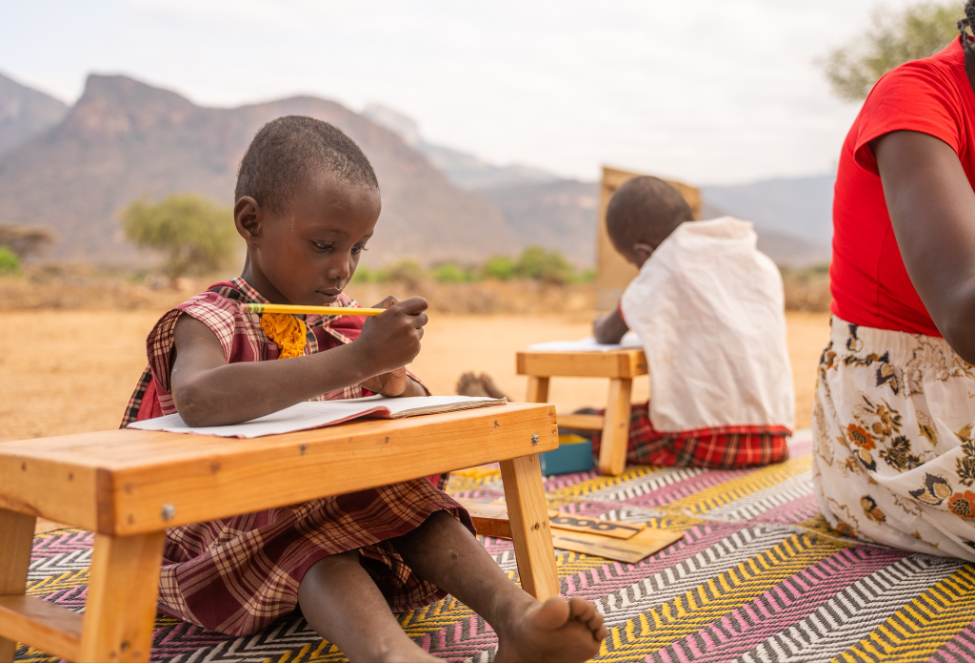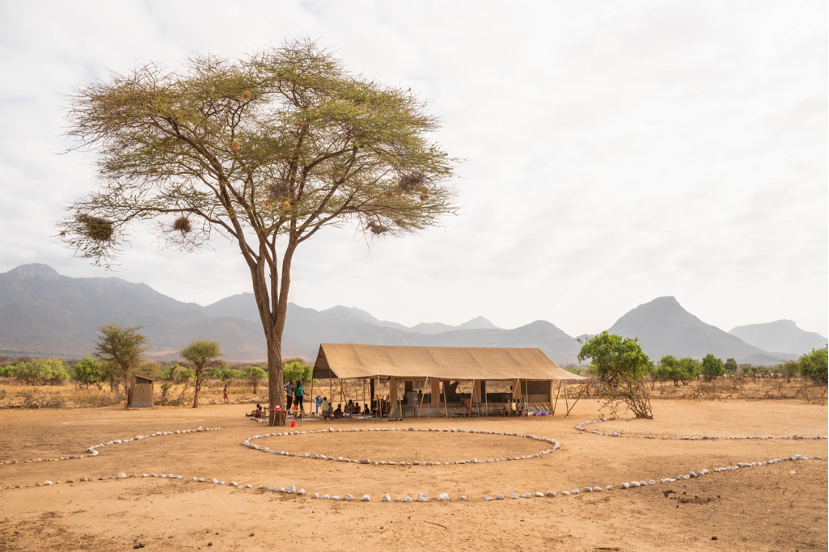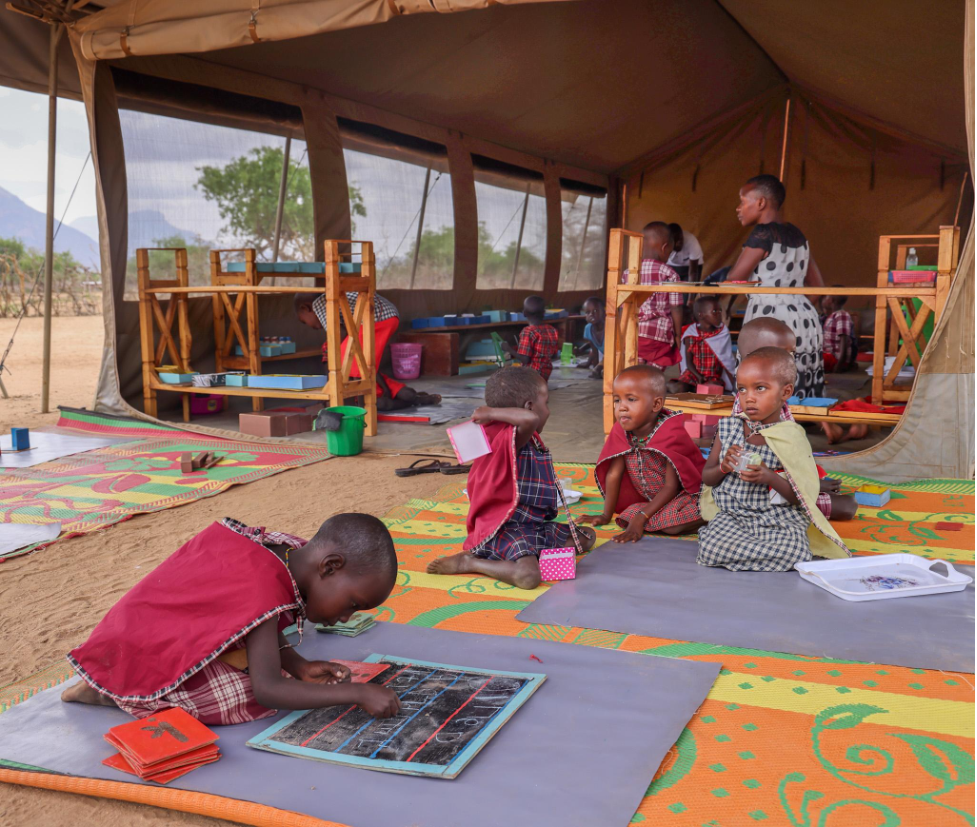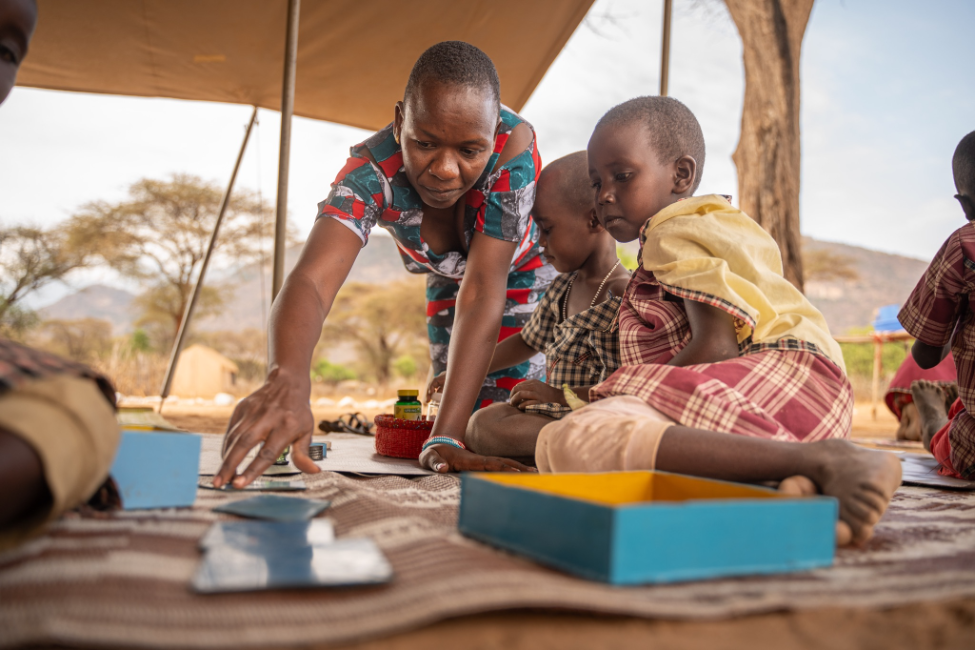the sarara foundation
Phonetic Planet was delighted to engage with The Sarara Foundation recently, in a conversation that is designed to inform, to educate and to reassure that the principles of Montessori’s educational philosophy have a universal relevance and are applicable to communities all over the world. We are supremely grateful to Judy Mugambi, Head of Education at Sarara Foundation, and also a teacher at the newly opened Louwai Obo school, for sharing some history of the foundation’s educational initiatives in Kenya, as well as painting for our readers a truly dynamic portrait of a vibrant, thriving community that can attest to the impact of a meaningful education.
It is also necessary for his psychic life to place the soul of the child in contact with creation, in order that he may lay up for himself treasure from the directly educating forces of living nature. - Maria Montessori
Thank you for agreeing to chat with us, Judy! Firstly, we’d love to learn a little about the location in which you are based?
We live in Northern Kenya, in the heart of County Samburu – and Samburu is our ethnic identity as well as the name of our land. This beautiful region features breathtaking mountains, valleys and plains, and it’s an arid zone with little rainfall. My home is in Sarara, which is within Namunyak Community Conservancy. Spanning 850,000 acres, it’s a pristine and unspoilt wilderness with a small population.
As one of the smallest communities in Kenya, there are only about 300,000 people in Samburu. Often referred to as the ‘Butterfly People’ because of our colourful clothing and accessories, the Samburu dress in brightly coloured traditional shukas (shawls) and everyone – especially women – are adorned with beautiful, intricately woven and heavily beaded necklaces, anklets and bracelets.
About 15,000 people live in Sarara and as we are pastoralists and semi-nomadic by nature, this number may increase or decrease depending on the weather, and the amount of pasture available for our livestock. Living with our herds of cattle, goats and sheep, we move with them in search of water and feed – and to this day, we’ve also co-existed in harmony with this region’s incredible wildlife for thousands of years.
Our landscape is incredibly diverse and varied, and also usually quite hot and dry! We only receive rain about once or twice a year – but when it rains, the landscape is transformed almost instantly into lush stretches of thick, green bush. Breathtaking and imposing, the mountains in the Matthews Range curl through Namunyak and frame every view, while its incredible old forest open up to unveil a wonderworld of streams, giant trees and the area’s rich bird- and wildlife.
Tintil Montessori School, Kenya
Our endless plains are dotted with eye-catching acacias and other large trees like loimugi and melia – and we are privileged to see numerous wild animals on a daily basis. These include elephants, buffaloes, giraffes, the endangered Grévy’s zebra, leopards, wild dogs, warthogs, dik-dik, impala, gerenuk and more. Not to mention the mesmerising range of birds, and colourful butterflies fluttering by!
Namunyak Community Conservancy entails a partnership between the Samburu people and private investors who have built eco lodges that bring in guests from far and wide. There are three lodges – Sarara Camp, Sarara Treehouses and Reteti House – all employing our local community throughout their operations. The Sarara Foundation was also established, and runs various programs – including a mobile health clinic, four Nomadic Montessori Schools, Eco Rangers who train and protect our rangeland and precious ecosystem, as well as enterprise development to improve livelihoods. In addition, we have the first community owned elephant sanctuary in Africa, Reteti Elephant Sanctuary, which rescues and takes care of abandoned and orphaned baby elephants. Altogether, more than 600 community members are employed by the lodges and the Foundation.
Can you please describe the lifestyle of the community in general?
Tintil Montessori School, Kenya
The Samburu have an intact and authentic culture, which means that we are traditionalists in a world of change. Many of us still live in traditional huts called manyattas, which are temporary structures made and repaired by women. In each homestead, there may be 5 or 6 manyattas with an open space in the center. Around it, we have a protective fence – which keeps our animals safely inside, and wild animals out at night. Work is usually done communally within a homestead. Children are often the ones who herd the goats and sheep, while the older boys and men will herd the cattle. In the evening, the women will milk the goats and cattle when they come home from grazing in the wild.
Tradition and rituals are important to the Samburu people. We love to sing and dance and don’t use any musical instruments – relying solely on the sound of our voices. The men usually dance in a circle jumping upright with their feet together. We come together forvarious celebrations, including initiation ceremonies, weddings and the blessings of community projects.
Every few months – when there’s scarcity of pasture or water – the homesteads will migrate and move to a new area. We’d then pack all our belongings onto our donkeys and move along with our animals to a new area. Once there, we’ll construct a new homestead, just like the ones we had left behind.
Has the community had various access to traditional education in the past? How did the community become aware of Montessori education?
Education among Samburu has traditionally been passed down orally and through interaction with older generations. The Samburu people do not follow typical ages, and instead have a system of age-sets, which is similar to that of the Maasai people. It organizes the community into different age groups, each with its own set of responsibilities and privileges. The age-sets are named after animals, and each one lasts for about 15 years.
Student in Ntaparani School, Kenya
When children are young, they are taught by their mothers at home about their natural environment. As they get older, distinctions are made between girls and the boys, with the latter being initiated into warriorhood through the process of circumcision. At that point, the young warriors will live outside of their mothers’ homes with their fellow warriors. The girls of the same age-set will remain at home being taught how to prepare to run their homes and families.
However, with modernity and a changing world, we have been introduced to the idea of western education and have slowly come to embrace and appreciate the benefit of engaging. In Namunyak, we only had two government schools which were far apart – andfar from our people. However, about six years ago, we had a guest who showed interest in our community and who wanted to help promote education. After many lengthy discussions between our community elders, our leaders decided that they’d like to have a school system, but one that was similar to our way of life and which would help us maintain and promote our traditional lifestyle. After examining the various systems that were available, it was agreed that the Montessori pedagogy and method of instruction was most appropriate.
The guest then engaged Lynn Lawrence, the Executive Director at Association Montessori Internationale in Amsterdam. Lynn had been involved in establishing and implementing Montessori in Kenya, but this was the first time it would be offered in a remote location and among a nomadic and pastoralist community. At that time, we didn’t have any local members who were trained in Montessori Education. However, Lynn knew Judy Mugambi – who had lived and studied in Samburu and who had been trained as a Montessori teacher. She persuaded her to come and start the first schools in Namunyak, and Judy agreed. Judy then convinced her former student, Terry Koskei, to join her and they then launched what eventually became the first nomadic schools! They would carry all their belongings, including the tents and school materials, on their back and move with the communities, living among them and teaching them.
Six years later, we have twelve local teachers trained in the Montessori method, with seven pursuing further diplomas in 3-6 and 6-12 in Mwanza, Tanzania. The schools have expanded and we have four tented schools which we pack down if we need to move with the communities. Currently, there are approximately 200 children in our class “rooms”, and to date approximately, 600 children have received education in our schools.
Please tell us as much as you like about the four beautiful Montessori schools, and how they came to exist in your community.
Nurse Dorcas and Nurse Parito carry out a health check.
We have four Montessori Schools, which are all located in Namunyak Conservancy. Most recently, we opened at school at Louwai Obo, on 8 September 2023. Our other schools are in Lengusaka, Ntaparani and Tintil.
Our schools are tented and our teachers also live in tents. They are located close to the communities and their manyattas, and the children who attend come from these manyattas. Over the holidays, we pack down our school materials and dismantle the tents. We also do this when we have to move to a new site.
We (the teachers) make most of our learning materials – and try to make them as relevant as possible to our natural environment. We teach the children about the animals, the trees, and the natural environment that they see. We also teach them in Maa (our local language), in Kiswahili (Kenya’s national language) and English (Kenya’s official language). We teach the children songs and poems in the three languages to reinforce their use of the three languages. The children wear traditionally inspired uniforms that remind them of their culture.
Judy, what is your hope for the future, regarding the lives of the students who attend your schools?
The thirst for knowledge and education in our children and our communities is growing and the Montessori Schools have been really impactful. Our children have ranked miles ahead of other schools in the county, with government officials and media touring our schools to assess our schools.
Outdoor reading with Teacher Meschak
We have 14 teachers teaching about 200 children and we could accept more children if we had more tents and more materials in each school, as well as more schools in other locations in the conservancy. In addition, we need to train more teachers from 0-3 and 3-6 but 6-12 so that we can increase the transition of children from our early years schools to elementary years. If we can have elementary years, we will be able to continue to influence our children in Montessori education and will prevent us losing them back to herding and pastoralism.
The Sarara Foundation recognises the stress placed on families with the ongoing drought and inadequate rains. It has implemented a nutrition program where the children receive nutritious porridge every day at school. The continuation of this program is essential for the children’s health and meeting their growth markers.
In addition, through close collaboration with the Foundation’s complementary programs, the children receive healthcare monitoring and treatment from the mobile health team, as well as education on the importance of protecting our natural environment and ecosystem from the Eco Rangers. Involvement of these two essential parts of our program ensures that we create resilience among our children and communities, and the sustainability and protection of our environment.
How do the children speak about their schools?
The children enjoy learning in their schools and absenteeism is very low. School is fun and the nature of independent and varied work is enjoyable. They enjoy speaking and learning in three languages and the camaraderie among fellow students and teachers. Those children who make the transition to government elementary schools are often placed in higher grades due to their advanced knowledge and skill. This gives them confidence and poise.
Teacher Stella guiding students
How can the Phonetic Planet community support your schools?
Creating or finding materials that are culturally and linguistically appropriate and specific can be a challenge. We would like to create books that we can use, not only in our schools, but which we can share with other schools in the county for the benefit of their students.
Our greater aim would be to create a facility where we could train more local teachers in the Montessori method for its enhancement in the greater Samburu County. We would need training, publicity and financial support to make this dream a reality.
You can learn more about The Sarara Foundation at
and you can also contribute towards their development fund at the following link:
https://donate.sararafoundation.org/give/410241/
Our sincere thanks to Judy Mugambi for taking the time to chat with us. We look forward to hosting a fundraiser in support of these beautiful schools in the near future! All photos used in this article were provided by The Sarara Foundation.
Follow The Sarara Foundation on Instagram @sararafoundation







